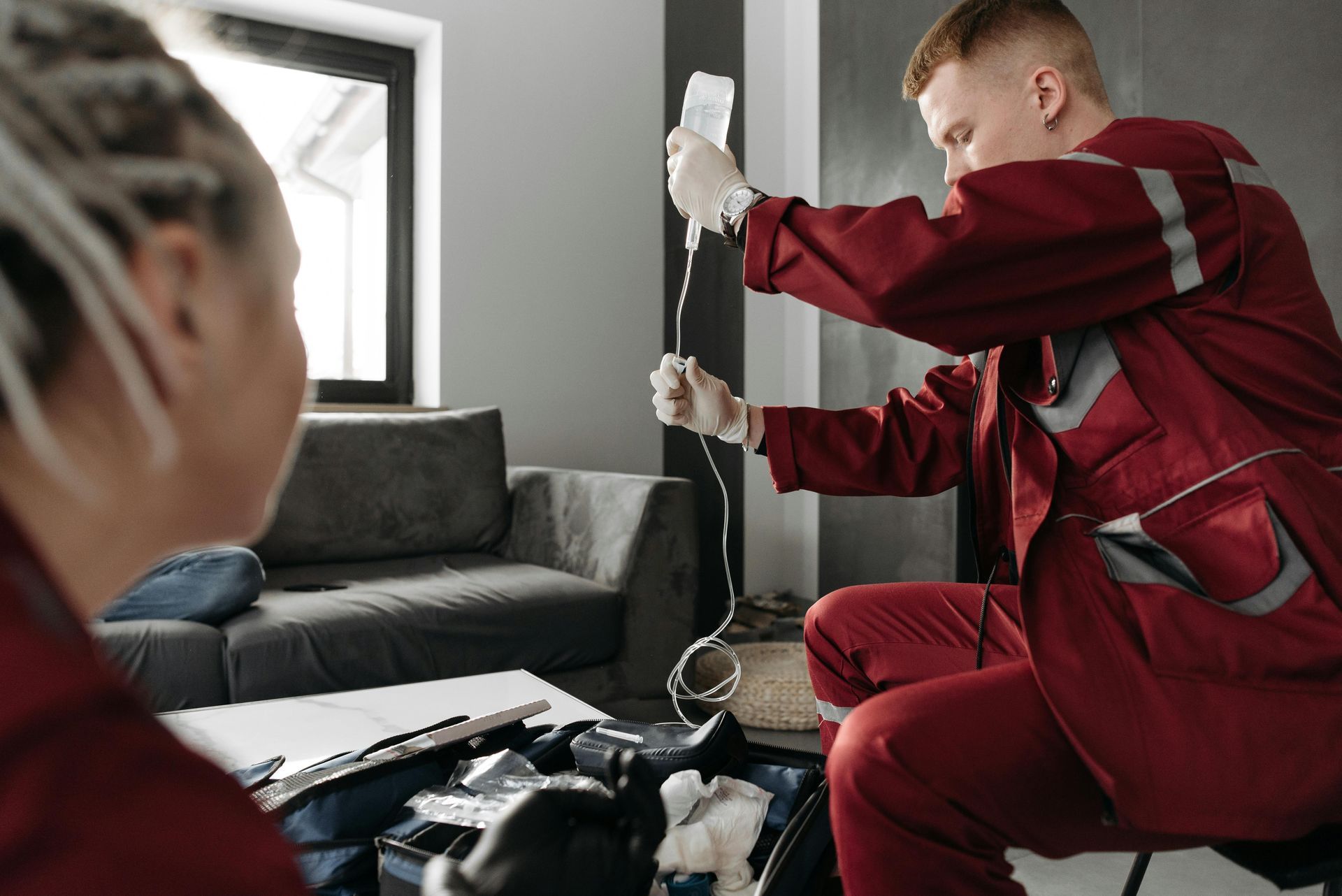At Home IV Treatment: Safely Administer Intravenous Therapy

Medically reviewed by Micaela Strevay, FNP-C, PMHNP-BC
Table of Contents

Looking after our health is of the utmost importance, but sometimes it can feel like the treatments we need are out of reach. Whether you're recovering from an illness or need ongoing treatment, intravenous (IV) therapy can be an effective solution. The good news is that with the right knowledge and resources, you can safely administer IV treatments at home. In this guide, we'll cover everything you need to know about IV therapy, from the benefits and common types of treatments to preparing for and administering IV therapy at home.
Understanding IV Therapy
What is IV Therapy?
IV therapy is the process of delivering fluids, medication, vitamins, and other essential nutrients directly into the bloodstream through a vein in the arm or hand. This allows for faster absorption and distribution throughout the body, making it a more efficient way to receive treatment.
IV therapy is commonly used in hospitals and clinics to treat a variety of conditions, including dehydration, malnutrition, and chronic illnesses. However, it has also become popular in recent years as a way to boost energy levels, improve immune function, and enhance overall wellness.
Benefits of IV Therapy
IV therapy can provide numerous benefits, including:
- Quicker and more effective absorption of medication and nutrients
- Customizable treatments to fit your specific needs
- Improved hydration and immune function
- Faster recovery times from illnesses and injuries
- Reduced risk of gastrointestinal side effects that can occur with oral medications
- Minimized risk of drug interactions
- Ability to deliver high doses of medication or nutrients that may not be possible with oral medications
Overall, IV therapy can be a safe and effective way to address a variety of health concerns.
Common Types of IV Treatments
Some of the most common IV treatments include:
- Hydration therapy to treat dehydration or hangovers
- Vitamin therapy to boost immune function and energy levels
- Nutrient therapy to address deficiencies
- Iron therapy to treat anemia
- Medication therapy for pain relief or maintenance of chronic conditions
Hydration therapy is often used to treat dehydration caused by excessive sweating, vomiting, or diarrhea. This type of treatment can also be effective for those who have consumed too much alcohol and are experiencing a hangover.
Vitamin therapy is a popular option for those looking to boost their immune function and energy levels. This type of treatment typically involves a combination of vitamins, including B vitamins, vitamin C, and vitamin D.
Nutrient therapy may be recommended for those who have deficiencies in certain vitamins or minerals. This can include iron, magnesium, or calcium.
Iron therapy is often used to treat anemia, a condition in which the body does not have enough red blood cells to carry oxygen to the tissues. This type of treatment may be recommended for those who have low levels of iron in their blood.
Medication therapy may be used for pain relief or to manage chronic conditions such as Crohn's disease, ulcerative colitis, or rheumatoid arthritis. IV medication can provide faster relief than oral medications and can be more effective for those who have difficulty swallowing pills.
Overall, IV therapy can be a safe and effective way to address a variety of health concerns. If you are interested in IV therapy, be sure to speak with your healthcare provider to determine if it is right for you.
Preparing for At-Home IV Therapy
Consultation with a Healthcare Professional
Before starting IV therapy at home, it's essential to consult with a healthcare professional. They can help determine if at-home treatment is appropriate for you and ensure that you have all the necessary medical information and instructions.
During the consultation, your healthcare professional will ask you about your medical history, including any current medications or supplements you're taking. They may also perform a physical examination to assess your overall health and determine the best course of treatment.
It's important to be honest and open with your healthcare professional about any concerns or questions you may have. They are there to help you and ensure that you receive the best possible care.
Acquiring the Necessary Equipment
You'll need to acquire the necessary equipment to administer IV therapy at home. This includes an IV drip, tubing, needles, and other supplies that your healthcare professional will recommend. You can purchase these from a medical supply store or online.
When purchasing equipment, it's important to ensure that it's of high quality and meets all necessary safety standards. Your healthcare professional can provide you with a list of recommended suppliers and products.
It's also important to have a backup supply of equipment in case of any malfunctions or emergencies. Your healthcare professional can provide you with guidance on how to properly store and maintain your equipment.
Setting Up a Clean and Safe Environment
It's crucial to set up a clean and safe environment for administering IV therapy at home. The area should be well-lit, clean, and free of distractions. Make sure to wash your hands thoroughly and sterilize all equipment before use.
You may want to consider setting up a designated area in your home for IV therapy administration. This can help ensure that the area remains clean and free of clutter.
It's also important to have a plan in place for handling any emergencies that may arise. Your healthcare professional can provide you with guidance on what to do in case of any adverse reactions or complications.
By following these steps and working closely with your healthcare professional, you can ensure a safe and effective at-home IV therapy experience.
Administering IV Therapy at Home
Administering IV therapy at home can be a convenient and cost-effective option for patients who require regular treatment. However, it's important to follow proper procedures to ensure the therapy is safe and effective.
Proper Hand Hygiene and Sterilization
Before starting the IV therapy, you should thoroughly wash your hands with soap and warm water for at least 20 seconds. Use a clean towel to dry your hands and avoid touching anything that is not sterile. Sterilize all equipment, including the IV needle, tubing, and any other supplies, according to the instructions provided by your healthcare professional. Wear gloves to minimize the risk of infection and change them if they become contaminated or torn.
It's also important to maintain a clean and sterile environment. Choose a space that is free from clutter and dust, and avoid touching surfaces that are not sterile. Use a sterile drape to cover the area where you will be administering the IV therapy.
Inserting the IV Needle
Inserting the IV needle can be challenging and should be done carefully to avoid discomfort, bleeding, and infection. Make sure you are in a comfortable position and have good lighting. Follow the instructions provided by your healthcare professional and take the time to ensure the needle is inserted correctly.
If you experience any pain or discomfort during the insertion, let your healthcare professional know immediately. You may need to adjust the position of the needle or use a different size or type of needle.
Monitoring the IV Drip Rate
It's important to monitor the IV drip rate, as too much or too little can cause complications. Follow the instructions provided by your healthcare professional and adjust the drip rate as necessary. Keep track of the amount of fluid that has been administered and the remaining amount.
Check the IV site regularly for signs of swelling, redness, or pain. If you notice any of these symptoms, stop the IV therapy and contact your healthcare professional immediately.
Recognizing and Addressing Complications
Despite careful preparation and administration, complications can still occur. Be aware of the signs of infection, such as redness, swelling, and pain around the IV site. If you experience any complications, contact your healthcare professional immediately.
Other complications that may occur include infiltration, which happens when the IV fluid leaks into the surrounding tissue, and phlebitis, which is inflammation of the vein. If you notice any of these symptoms, stop the IV therapy and contact your healthcare professional immediately.
It's important to follow up with your healthcare professional regularly to ensure the IV therapy is working effectively and to address any concerns or complications that may arise.
Aftercare and Maintenance
IV therapy is a common medical procedure that involves the administration of fluids, medication, or nutrients directly into a patient's bloodstream through a vein. After receiving IV therapy, it's important to take proper care of the IV site to prevent infection and promote healing.
Removing the IV Needle Safely
When it's time to remove the IV needle, it's important to do so carefully to avoid bleeding or infection. Your healthcare professional will provide you with specific instructions on how to remove the needle safely. Typically, the needle will be gently pulled out of the vein while pressure is applied to the site to prevent bleeding. Once the needle is removed, a bandage or dressing will be applied to the site to protect it.
Disposing of Used Equipment
Proper disposal of used IV equipment is crucial to prevent the spread of infection. Your healthcare professional will provide you with specific guidelines on how to dispose of all used equipment. This typically involves placing all used supplies in a container and disposing of it in the trash or at a medical waste facility. It's important to follow these guidelines carefully to prevent contamination.
Caring for the IV Site
After the IV therapy is complete, it's important to care for the site properly to promote healing and prevent infection. Keep the area clean and dry, and avoid getting the site wet for at least 24 hours after the IV has been removed. If the site becomes red, swollen, or painful, or if you notice any drainage or discharge, contact your healthcare professional immediately. They may recommend applying a warm compress to the site to promote healing and reduce discomfort.
It's also important to monitor the IV site for any signs of infection, such as redness, swelling, or warmth around the site, or fever. If you experience any of these symptoms, contact your healthcare professional immediately. They may recommend antibiotics or other treatments to prevent the infection from spreading.
Finally, it's important to follow any aftercare instructions provided by your healthcare professional. This may include avoiding certain activities or medications, or returning for follow-up appointments to monitor your progress. By taking proper care of your IV site and following your healthcare professional's instructions, you can ensure a speedy recovery and prevent complications.
Risks and Considerations
IV therapy is a medical treatment that involves the administration of fluids, medications, or nutrients directly into a patient's bloodstream through a vein. While IV therapy can be a safe and effective way to deliver essential fluids and nutrients to the body, there are some risks and considerations to keep in mind.
Potential Side Effects and Complications
Like any medical treatment, IV therapy comes with potential side effects and complications. Some of the most common side effects of IV therapy include:
- Infection: There is a risk of infection any time a needle is inserted into the skin. Infection can occur if the needle or IV site is not properly cleaned or if the needle is not inserted correctly.
- Bleeding: There may be some bleeding at the IV site, especially if the needle punctures an artery or if the vein is fragile.
- Discomfort: IV therapy can be uncomfortable, especially if the needle is inserted into a sensitive area or if the IV site becomes irritated.
- Vein irritation: The fluids and medications administered through an IV can irritate the vein and cause inflammation or swelling.
It's important to note that these side effects are rare and can usually be prevented or managed with proper care and attention from a healthcare professional.
When to Seek Medical Assistance
If you experience severe pain, bleeding, or infection, or any other severe side effects or complications, seek medical assistance immediately. It's also important to monitor the IV site for any signs of infection, such as redness, swelling, or discharge. If you notice any of these symptoms, contact your healthcare provider right away.
Alternatives to At-Home IV Therapy
If at-home IV therapy isn't appropriate for you, there are many alternative treatments and therapies available. Your healthcare provider may recommend oral medication or traditional in-hospital IV treatments as an alternative. It's important to discuss all of your treatment options with your healthcare provider to determine the best course of action for your individual needs.
Frequently Asked Questions about IV Therapy at Home
IV therapy, or intravenous therapy, is a medical treatment that involves delivering fluids, medication, or nutrients directly into a patient's bloodstream through a vein. While traditionally administered in a hospital or clinic setting, IV therapy can also be done at home under proper medical supervision. Here are some frequently asked questions about IV therapy at home:
Can Anyone Administer IV Therapy at Home?
No, only trained healthcare professionals or individuals who have been trained under their guidance should administer IV therapy at home. This is because IV therapy involves inserting a needle into a vein, which can be dangerous if done improperly. It is important to have someone who is trained to perform this procedure to ensure that it is done safely and effectively.
How Long Does an IV Treatment Take?
The length of the IV treatment will depend on the type of treatment and your individual needs. Your healthcare professional should provide an estimated time frame for the treatment. Some treatments may only take a few minutes, while others may take several hours. It is important to discuss the length of the treatment with your healthcare provider so that you can plan accordingly.
Is At-Home IV Therapy Covered by Insurance?
IV therapy may be covered by insurance, depending on your individual plan. Check with your insurance provider for more information. Some insurance plans may cover the cost of the equipment and supplies needed for at-home IV therapy, while others may cover the cost of a home healthcare provider who can administer the treatment. It is important to understand what your insurance plan covers before pursuing at-home IV therapy.
While at-home IV therapy can be a convenient option for some patients, it is important to approach it with caution. Here are some additional tips for safely administering IV therapy at home:
- Consult with a healthcare professional before starting any at-home IV therapy
- Acquire the necessary equipment from a reputable source
- Set up a clean and safe environment for administering the treatment
- Follow the instructions provided by your healthcare professional for administering the treatment
- Monitor for complications, such as infection or infiltration
- Follow aftercare instructions provided by your healthcare professional
In conclusion, at-home IV therapy can be a safe and effective way to receive treatment when done properly. Consulting with a healthcare professional, acquiring the necessary equipment, setting up a safe environment, and administering the treatment correctly are crucial steps in ensuring a positive outcome. Always monitor for complications and follow aftercare instructions. With this knowledge and guidance, you can receive the treatment you need from the comfort of your own home.





